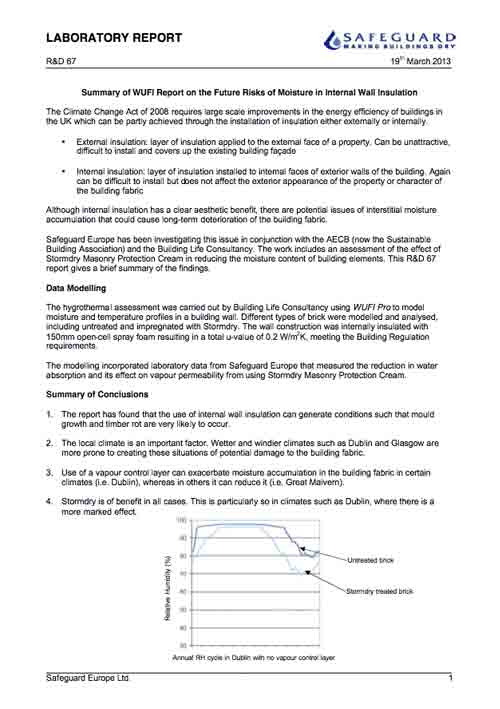Simulation of Stormdry Use to Protect Spray Foam Insulation
This was a data analysis report performed by The Building Life Consultancy, using sophisticated simulation software in 2012.
Report Aims
The Building Life Consultancy, one of Ireland's leading consultancies evaluating the performance of buildings and their materials, was asked by an architect to carry out an assessment for a specific project. The architect was working on a building renovation where internal spray foam insulation, utilising an open timber frame, was to be installed.
It was hoped that Stormdry could be an effective way to guard against the build-up of interstitial moisture between the insulation and the exterior wall, protecting the property from interstitial condensation and possible mould or rot growth. The Building Life Consultancy was asked to give their assessment on whether Stormdry would help reduce the likelihood of structural problems due to condensation, rot or mould growth.
Report Method
The Building Life Consultancy decided to use WUFI Pro to model the proposed construction set up. WUFI Pro is a software package for calculating heat and moisture transfer in building components. It simulates the effect of real-world weather patterns on different types of wall construction.
Simulations were run on the closest matching materials in the WUFI Pro database. A variety of different brick types were simulated but, in all cases, the other materials stayed the same. The make-up of the simulated wall was as follows, in order of materials from the exterior face to the interior face:
- 10mm of Stormdry treated brickwork, using data provided by the Safeguard Europe laboratory
- 317mm of regular brickwork, of which the final 75mm included built-in oak timber frame pieces
- 150mm of open cell spray foam, of which the final 50mm included timber studs
- A vapour barrier
- 12.5mm of plasterboard
Two types of 5 year simulation were run. The first type was for 2 years without the insulation or the Stormdry and then 3 years with the insulation but no Stormdry. The second type was for 2 years without the insulation or the Stormdry and then 3 years with the insulation and the Stormdry added. Once the simulations had been run, it was possible to see the relative humidity of each component part of the wall, at any point during the 5 years that had been simulated.
Each group of simulations was run in a variety of weather conditions. The weather data was gathered using Meteonorm climate files, the industry accepted standard for all tests of this nature. The three locations that the weather data was gathered from were Great Malvern, Dublin & Glasgow.
Conclusions
After looking at the numerous results and analysing the data, The Building Life consultancy came up with the following conclusions about Stormdry:
- Stormdry was a significant benefit in all the simulated situations. In two of three types of simulated bricks, the relative humidity in the Stormdry treated wall never went above the level where condensation, rot or mould growth became a possibility.
- Stormdry did not have a detrimental effect in any of the situations, because it is breathable and allows a wall to dry out naturally. A weather proofing layer that is not vapour permeable would be unable to let any moisture vapour that is present to escape the wall.
- The local climate is an important factor. Wetter and windier climates such as Dublin and Glasgow are more prone to creating situations where rot & mould growth can become a problem.


